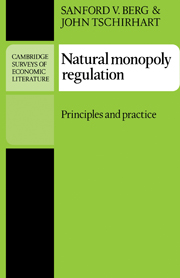Book contents
- Frontmatter
- Contents
- Preface
- 1 Introduction to regulatory economics
- Part I Optimal pricing and investment for natural monopolies
- 2 Natural monopoly and the justification for regulation
- 3 Efficient pricing using linear prices
- 4 Efficient pricing using nonlinear prices
- 5 Peak-load pricing
- 6 Pricing and capacity under stochastic demand
- 7 Sustainability of natural monopolies
- Part II Natural monopoly regulation in practice
- References
- Author index
- Subject index
3 - Efficient pricing using linear prices
Published online by Cambridge University Press: 06 November 2009
- Frontmatter
- Contents
- Preface
- 1 Introduction to regulatory economics
- Part I Optimal pricing and investment for natural monopolies
- 2 Natural monopoly and the justification for regulation
- 3 Efficient pricing using linear prices
- 4 Efficient pricing using nonlinear prices
- 5 Peak-load pricing
- 6 Pricing and capacity under stochastic demand
- 7 Sustainability of natural monopolies
- Part II Natural monopoly regulation in practice
- References
- Author index
- Subject index
Summary
The marginal-cost pricing rule implies that an allocative inefficiency arises when there is a deviation between the value consumers place on an additional unit of the product and the opportunity cost of producing that additional unit. Constraints on the price structure of a firm can lead to allocative inefficiencies, as some consumers face a price that is unequal to marginal cost. The question then arises how regulators can minimize the misallocations associated with (self-imposed) pricing constraints, particularly because underconsumption and overconsumption both involve deadweight losses. The design of prices for a multiproduct firm involves balancing the marginal welfare losses across product markets as prices deviate from marginal costs.
The assumption throughout this chapter is that the firm being studied is a natural monopoly; therefore, from an efficiency viewpoint, cost minimization requires that it be the only firm in the market or markets it serves. We also assume that the firm is a strong natural monopoly, so that marginal-cost pricing of all outputs will create a deficit, and enforcing marginal-cost pricing with subsidies is not an option. Finally, we assume that there are barriers to entry. We know from Chapter 2 that regulation is justified in this instance. In this chapter, regulation takes the form of maximizing social welfare subject to a break-even constraint with a linear price system, that is, a system in which a constant price per unit is charged in each market, although the prices can vary across markets.
The situation described is essentially the problem of second-best pricing.
- Type
- Chapter
- Information
- Natural Monopoly RegulationPrinciples and Practice, pp. 53 - 102Publisher: Cambridge University PressPrint publication year: 1989



